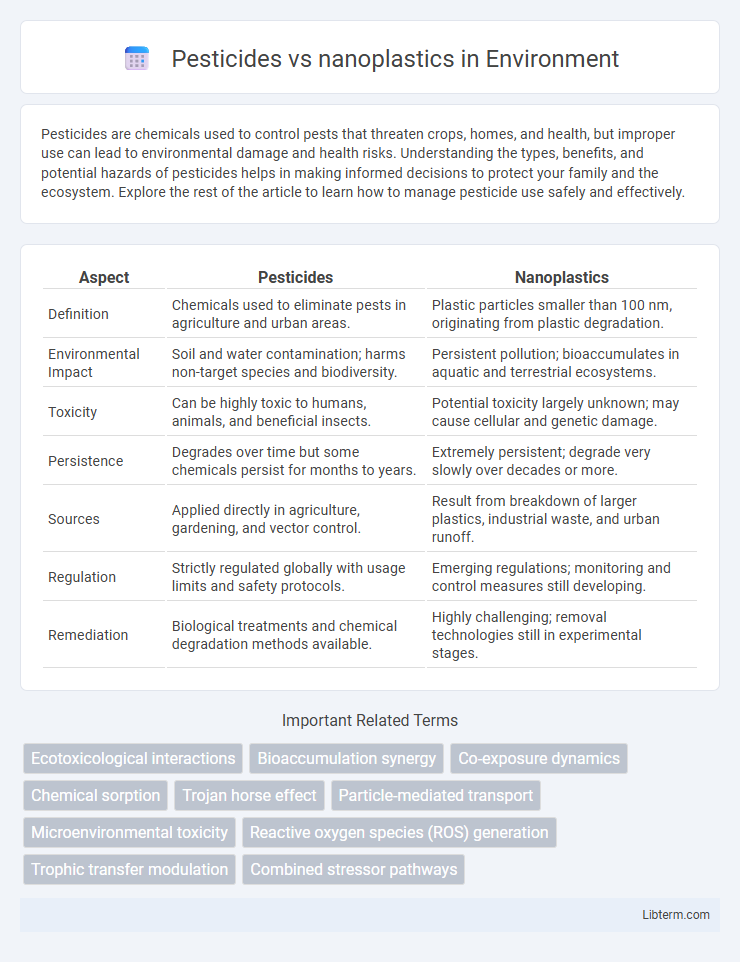Pesticides are chemicals used to control pests that threaten crops, homes, and health, but improper use can lead to environmental damage and health risks. Understanding the types, benefits, and potential hazards of pesticides helps in making informed decisions to protect your family and the ecosystem. Explore the rest of the article to learn how to manage pesticide use safely and effectively.
Table of Comparison
| Aspect | Pesticides | Nanoplastics |
|---|---|---|
| Definition | Chemicals used to eliminate pests in agriculture and urban areas. | Plastic particles smaller than 100 nm, originating from plastic degradation. |
| Environmental Impact | Soil and water contamination; harms non-target species and biodiversity. | Persistent pollution; bioaccumulates in aquatic and terrestrial ecosystems. |
| Toxicity | Can be highly toxic to humans, animals, and beneficial insects. | Potential toxicity largely unknown; may cause cellular and genetic damage. |
| Persistence | Degrades over time but some chemicals persist for months to years. | Extremely persistent; degrade very slowly over decades or more. |
| Sources | Applied directly in agriculture, gardening, and vector control. | Result from breakdown of larger plastics, industrial waste, and urban runoff. |
| Regulation | Strictly regulated globally with usage limits and safety protocols. | Emerging regulations; monitoring and control measures still developing. |
| Remediation | Biological treatments and chemical degradation methods available. | Highly challenging; removal technologies still in experimental stages. |
Introduction to Pesticides and Nanoplastics
Pesticides are chemical substances used extensively in agriculture to control pests and enhance crop yields, containing compounds like organophosphates, carbamates, and neonicotinoids that can persist in soil and water ecosystems. Nanoplastics, tiny plastic particles typically less than 100 nanometers in size, result from the breakdown of larger plastic debris and are emerging contaminants in marine and terrestrial environments due to their ability to adsorb toxic chemicals. The interaction between pesticides and nanoplastics poses significant environmental risks, influencing the bioavailability, transport, and toxicity of both pollutants in ecosystems.
Chemical Composition and Properties
Pesticides primarily consist of organic compounds like organophosphates, carbamates, and pyrethroids, designed for pest control with specific chemical stability and biodegradability profiles. Nanoplastics are typically composed of synthetic polymers such as polyethylene, polystyrene, and polypropylene, exhibiting high surface area-to-volume ratios and resistance to environmental degradation. The distinct chemical structures influence their environmental interactions, toxicity mechanisms, and persistence in ecosystems.
Sources and Environmental Pathways
Pesticides originate primarily from agricultural applications and industrial processes, entering ecosystems through runoff, leaching, and atmospheric deposition. Nanoplastics are derived from the degradation of larger plastic debris, releasing micro- and nanoscale particles into aquatic and terrestrial environments via wastewater discharge, stormwater, and soil erosion. Both contaminants exhibit extensive environmental mobility, contaminating water bodies, soils, and the atmosphere, thereby posing significant risks to ecosystems and human health.
Mechanisms of Toxicity
Pesticides exert toxicity primarily through biochemical interactions that inhibit essential enzymes and disrupt neurotransmission, leading to oxidative stress and cellular damage. Nanoplastics induce toxicity by penetrating cellular membranes, causing physical damage, generating reactive oxygen species, and triggering inflammatory responses at the molecular level. Both agents compromise physiological functions but differ in their molecular targets and bioaccumulation pathways, influencing ecosystem and human health risks.
Bioaccumulation and Food Chain Impacts
Pesticides and nanoplastics both exhibit significant bioaccumulation potential, leading to toxic effects that amplify through food chains. Pesticides, especially organochlorines, persist in fatty tissues of organisms, causing biomagnification across trophic levels, while nanoplastics accumulate by adsorbing harmful chemicals and penetrating cellular membranes. These contaminants disrupt aquatic and terrestrial ecosystems by impairing reproductive, immune, and metabolic functions in key species, resulting in biodiversity loss and altered food web dynamics.
Human Health Risks
Pesticides and nanoplastics both pose significant human health risks through exposure and bioaccumulation, but their mechanisms differ. Pesticides are linked to acute poisoning, endocrine disruption, and increased cancer risk due to their chemical toxicity, while nanoplastics can penetrate biological barriers, causing inflammation, oxidative stress, and potential neurotoxicity. Chronic exposure to both contaminants demands comprehensive assessment to understand their synergistic effects on respiratory, digestive, and immune systems.
Ecological Consequences
Pesticides disrupt soil biodiversity by harming beneficial microorganisms, leading to reduced nutrient cycling and impaired ecosystem productivity. Nanoplastics accumulate in aquatic environments, causing physical and chemical toxicity that affects plankton, fish, and higher trophic levels, threatening food web stability. Both contaminants contribute to bioaccumulation and biomagnification, exacerbating ecological imbalances and biodiversity loss.
Regulatory Frameworks and Guidelines
Regulatory frameworks for pesticides are well-established, with agencies like the EPA enforcing strict guidelines on usage, residue limits, and environmental impact assessments to ensure safety and compliance. In contrast, nanoplastics lack comprehensive regulations, as their environmental and health risks are still being researched, resulting in fragmented guidelines and limited monitoring protocols globally. Emerging policies are increasingly emphasizing the need for standardized testing methods and risk assessment models to address the unique challenges posed by nanoplastics alongside traditional pesticide regulations.
Emerging Research and Innovations
Emerging research reveals distinct mechanisms of environmental impact for pesticides and nanoplastics, with pesticides primarily disrupting endocrine systems in aquatic species and nanoplastics causing cellular toxicity through oxidative stress. Innovations in nanotechnology enable the development of targeted pesticide delivery systems that reduce environmental runoff and bioaccumulation, while advanced filtration techniques employing nanomaterials aim to capture and degrade nanoplastics in water sources. Ongoing studies focus on the synergistic effects of pesticide-nanoplastic mixtures, highlighting the need for integrated mitigation strategies to address their combined ecological risks.
Sustainable Solutions and Future Directions
Sustainable solutions addressing pesticides and nanoplastics emphasize biodegradable alternatives and advanced filtration technologies to reduce environmental contamination. Research prioritizes eco-friendly pesticides derived from natural compounds and nanomaterial-based sensors for early detection and removal of nanoplastics in water sources. Future directions include integrating nanotechnology with bioremediation to enhance degradation efficiency and developing regulatory frameworks promoting circular economy principles in agricultural and plastic use.
Pesticides Infographic

 libterm.com
libterm.com